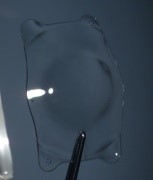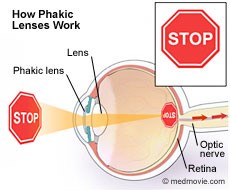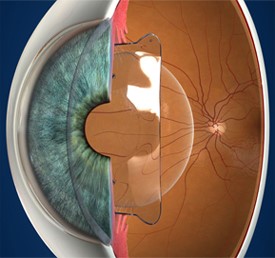The Phakic IOL (ICL/IPCL) is a FDA approved non-laser treatment for refractive error in which IOL is that are implanted in front of the normal lens, without reshaping the cornea in a candidate not ideal or those found unfit for LASIK, PRK etc.
What is Phakic lens (ICL/IPCL) IPCL?
The Phakic IOL (ICL/IPCL) is a FDA approved non-laser treatment for refractive error in which IOL is that are implanted in front of the normal lens, without reshaping the cornea in a candidate not ideal or those found unfit for LASIK, PRK etc.
Each thin, foldable lens is uniquely tailored to your eye, and custom made for you
IPCL is like a soft contact lens, single piece posterior chamber phakic IOL , which can be inserted into eye through sub 2.8 mm incision.

How do Phakic lens (ICL/IPCL) work?
Phakic lens(ICL/IPCL) are made from a special ‘biocompatible’ material that works with your body’s natural chemistry. Each thin, foldable lens is uniquely tailored to your eye, and custom made for you.
Your custom made (ICL/IPCL) are inserted behind your iris (the coloured part of your eye) and in front of your eye’s natural lens during a short, virtually painless procedure.
They alter the focusing point of your eye to give you clearer vision, in the same way that external contact lenses does except (ICL/IPCL) are surgically placed inside the eye.

How do I know if I am a suitable candidate for Phakic lens (ICL/IPCL) ?
- Candidates for the ICL/IPCL are above 18 years of age and refraction should be stable.
- Candidate with refractive error who are unsuitable for laser refractive surgery due to thin cornea or high myopia.
- Pregnant or nursing women should wait to have the ICL/IPCL implanted.
- Candidate without a large enough anterior chamber depth or low endothelial cell density may not be a good ICL/IPCL candidate.
- Candidate should consult their eye surgeon for more information, including an assessment of their candidacy.
Procedure of Phakic lens (ICL/IPCL)
- The implant surgery is quick and painless, lasting only about 10-15 minutes Local anaesthetic eye drops will be used to numb your eyes.
- When your eye is completely numb, an eyelid speculum will be placed between your eyelids to keep you from blinking during the procedure.
- Phakic iol (ICL/IPCL) is inserted by an ophthalmologist through micro incision (2.8mm)
- It is placed inside the eye just behind Iris in front of Crystalline lens.
STEPS OF SURGERY

Firstly, a tiny incision will be made where the white of your eye meets with the coloured part

Second, a gel like substance wil be injected into your eye & ICL will be injected in front of your iris

Then ICL will be carefully placed behind the iris & the gel is removed
Most patients resume normal activities within 3-4 days.
Successfully implanted Phakic lens (ICL/IPCL)

Advantages of Phakic lens ( IPCL/ICL)
- High quality of vision.
- Retains corneal asphericity.
- Almost all levels of power can be treated In comparison to other refractive procedures, the ICL offers the widest treatment range for correction of vision.
- Easily removed or replaced ( 5 - 10 minutes).
- Fast recovery.
- No dry eye.
Potential risks of Phakic lens (ICL/IPCL)?
Overcorrection : This complication occurs if the prescriptive power of the implanted ICL is too strong. In most cases it can be corrected with corrective eyewear or with an ICL replacement.
Undercorrection : The opposite of overcorrection, undercorrection is the result of an implantable contact lens with too weak of a prescription. Correction methods are similar to those of overcorrection.
Infection : During most surgeries, there is a potential risk of an infection.
Increased Intraocular Pressure :Pressure may build in the eye after an ICL procedure. The sooner a surgeon is alerted to this, the greater the chance of avoiding serious damage.
This is detected during your follow up visits with us or in case you face acute blurring of vision or headaches, you must visit the eye clinic. ICL may rarely need to be repositioned.
Damage to Crystalline Lens : This lens has unique properties of multifocality as well as toricity. It offeres minimal dependence on glasses to patients who have pre-existing corneal astigmatism, thus allowing a full range of distance, intermediate, and near vision Your doctor will suggest which IOL is suitable for your eye condition and your visual requirement.
Cataract Development : Most of the population will develop cataracts by the age of 65, however, it is believed that the use of phakic iol may cause cataracts at an earlier age, this however is rare.
Retinal Detachment : High Myopic patients are already at high risk of Retinal Detachment. Less than 1 percent of patients in the clinical studies were affected by retinal detachment. It should be noted, however, that the occurrence of retinal detachment increased as the degree of myopia increased.
FAQ
What is the anesthesia & discomfort involved?
A painless procedure, it is done using the Topical anaesthetic eye drops. Reasonable cooperation is required on part of the patient who has to stare into a bright light while the surgery is done which takes about 10-15 minutes. Some degree of pressure and stretching in the eye may be felt.
Will I be able to feel phakic IOL as contact lens once its in place?
Contact lens is in front of cornea and will touch to eye lid during its movement. So contact lens can be felled. But Phakic lens is so well inside the eye that it causes no feeling at all.
Whether Phakic Lens can be removed ?
Phakic lenses are intended to be permanent.
Once inplanted it is in eye for life. But if the situation arises it can be removed form the eye within 10 minutes.
What are the precautions & care after the surgery?
Rest is advised for 1-2 days after the surgery following which light routine activities can be resumed. Visually strenuous work can be resumed after 1 week whereas vigorous physical activity should be avoided for a month. Splashing of water into eyes, swimming and eye-makeup should be avoided for a month.